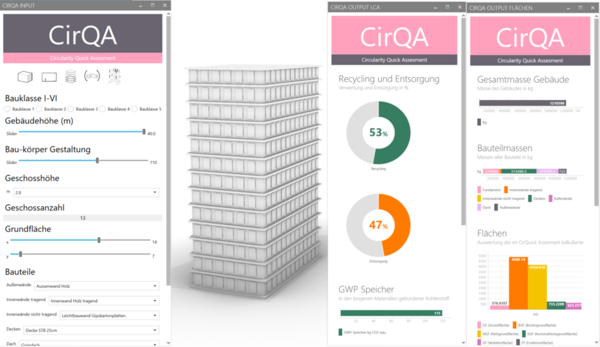The digital tool CirQA is designed for the quick assessment of circularity in the early stages of building design. It integrates Life Cycle Assessment (LCA) and circularity principles to enable informed decision-making and identify opportunities for improvement.
In the face of increasing global environmental challenges—such as global warming, rising sea levels, and extreme weather events—addressing the environmental impacts of construction activities is becoming urgent. One of the key challenges is to create tools that offer quick, accurate assessments while remaining intuitive and accessible to users with varying expertise in sustainability, LCA, and circular economy principles in the architecture, engineering, and construction (AEC) industries.
The CirQA project addresses this challenge by developing a Circularity Quick Assessment Tool tailored for early design stage building design. Current approaches often fail to provide sufficient data on circularity and environmental performance in the early design stage, where key decisions that shape a building’s lifecycle are made. The tool integrates parametric design techniques, structured data generation, and LCA methodologies to assess environmental impacts and circularity metrics. By utilizing digital platforms such as Rhino3D/Grasshopper and MS Excel, CirQA facilitates the creation of flexible and adaptable building models that enhance resource efficiency. It aligns with key frameworks such as ISO 14044:2006, EN 15804, EN 15978, and the EU Level(s) Framework to ensure that designs are evaluated according to robust sustainability standards.
PROJECT GOALS
- Develop an easy-to-use digital tool for assessing the circularity of building designs in the early stages.
- Address the current lack of early design stage assessment tools that also consider the end of life.
- Integrate LCA methodologies to quantify the environmental impacts of design choices.
- Embed circular economy principles, including waste minimization, resource optimization, and material reuse.
- Provide support for informed decision-making in sustainable construction and urban planning.
- Facilitate the creation of adaptable building models through parametric design approaches and structured data input.
AIT is leading the further development of the CirQA tool. Its responsibilities include optimizing the LCA framework, optimizing the assessment algorithms, and integrating various digital methods. AIT ensures that the tool is aligned with European sustainability standards and effectively implements circular economy objectives in building design processes.
PROJECT RESULTS
The CirQA prototype has been developed and successfully tested. Initial user feedback confirms the tool’s effectiveness in integrating circular economy principles into the design process at the early stages. Additional refinements and improvements are planned based on ongoing user input and further testing.
![[Translate to English:] Smart and Carbon-Neutral Urban Development Symbolfoto: Das AIT ist Österreichs größte außeruniversitäre Forschungseinrichtung](/fileadmin/_processed_/a/d/csm_Thermalkataster_Hotspots_7969d57e54.jpg)




